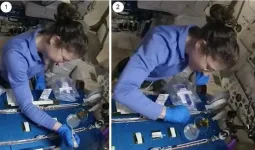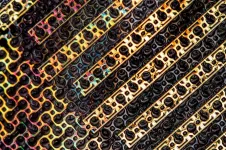Astronauts demonstrate CRISPR/Cas9 genome editing in space
First successful use aboard International Space Station of new technique for studying DNA repair in yeast
2021-06-30
(Press-News.org) Researchers have developed and successfully demonstrated a novel method for studying how cells repair damaged DNA in space. Sarah Stahl-Rommel of Genes in Space and colleagues present the new technique in the open-access journal PLOS ONE on June 30, 2021.
Damage to an organism's DNA can occur during normal biological processes or as a result of environmental causes, such as UV light. In humans and other animals, damaged DNA can lead to cancer. Fortunately, cells have several different natural strategies by which damaged DNA can be repaired. Astronauts traveling outside of Earth's protective atmosphere face increased risk of DNA damage due to the ionizing radiation that permeates space. Therefore, which specific DNA-repair strategies are employed by the body in space may be particularly important. Previous work suggests that microgravity conditions may influence this choice, raising concerns that repair might not be adequate. However, technological and safety obstacles have so far limited investigation into the issue.
Now, Stahl-Rommel and colleagues have developed a new method for studying DNA repair in yeast cells that can be conducted entirely in space. The technique uses CRISPR/Cas9 genome editing technology to create precise damage to DNA strands so that DNA repair mechanisms can then be observed in better detail than would be possible with non-specific damage via radiation or other causes. The method focuses on a particularly harmful type of DNA damage known as a double-strand break.
The researchers successfully demonstrated the viability of the novel method in yeast cells aboard the International Space Station. They hope the technique will now enable extensive research into DNA repair in space. This study marks the first time that CRISPR/Cas9 genome editing has successfully been conducted in space, as well as the first time in space that live cells have undergone successful transformation--incorporation of genetic material originating from outside the organism.
Future research could refine the new method to better mimic the complex DNA damage caused by ionizing radiation. The technique could also serve as a foundation for investigations into numerous other molecular biology topics related to long-term space exposure and exploration.
"It's not just that the team successfully deployed novel technologies like CRISPR genome editing, PCR, and nanopore sequencing in an extreme environment, but also that we were able to integrate them into a functionally complete biotechnology workflow applicable to the study of DNA repair and other fundamental cellular processes in microgravity," said senior author Sebastian Kraves. "These developments fill this team with hope in humanity's renewed quest to explore and inhabit the vast expanse of space."
First author Sarah Stahl Rommel adds, "Being a part of Genes in Space-6 has been a highlight of my career. I saw firsthand just how much can be accomplished when the ideas of innovative students are supported by the best from academia, industry, and NASA. The expertise of the team resulted in the ability to perform high-quality, complex science beyond the bounds of Earth. I hope this impactful collaboration continues to show students and senior researchers alike what is possible onboard our laboratory in space."
Co-author Sarah Castro-Wallace says, "It was an honor to support Genes in Space-6. I am still blown away by the incredible sophistication of the science that was realized when an organism was transformed, its genome edited with CRISPR/Cas9 to cause breaks in the DNA, followed by its growth to allow for DNA repair, and, finally, its DNA sequenced, all in the spaceflight environment onboard the ISS. The ability to perform this all-encompassing, end-to-end investigation is a huge step forward for space biology. This caliber of work speaks to both the exceptional students and the Genes in Space Program."
INFORMATION:
Citation: Stahl-Rommel S, Li D, Sung M, Li R, Vijayakumar A, Atabay KD, et al. (2021) A CRISPR-based assay for the study of eukaryotic DNA repair onboard the International Space Station. PLoS ONE 16(6): e0253403. https://doi.org/10.1371/journal.pone.0253403
Funding: This study was funded by miniPCR bio and Boeing.
Competing Interests: E.A.S., E.J.G., and S.K. are employed by miniPCR bio, manufacturer of the device used for transformation, DNA extraction, and DNA amplification. D.S.C and K.D.F. are employed by Boeing and S.S.R. and C.L.C. are employed by JES Tech. This does not alter our adherence to PLOS ONE policies on sharing data and materials. The remaining authors declare no competing financial interests.
In your coverage please use this URL to provide access to the freely available article in PLOS ONE: https://journals.plos.org/plosone/article?id=10.1371/journal.pone.0253403
[Attachments] See images for this press release:

ELSE PRESS RELEASES FROM THIS DATE:
2021-06-30
An important function of our vision is to segregate relevant figures from the irrelevant background. When we look at a visual stimulus, it drives a cascade of neural activity from low-level to higher level visual brain areas. The higher areas also provide feedback to the lower areas, where figures elicit more activity than the background, as if figures in the brain are highlighted with extra activity. Researchers from the Netherlands Institute of Neuroscience (NIN) now showed that feedback causes the extra neuronal activity in low-level areas and that the extra activity is essential for figure-ground ...
2021-06-30
MIT engineers and researchers in South Korea have developed a sweat-proof "electronic skin" -- a conformable, sensor-embedded sticky patch that monitors a person's health without malfunctioning or peeling away, even when a wearer is perspiring.
The patch is patterned with artificial sweat ducts, similar to pores in human skin, that the researchers etched through the material's ultrathin layers. The pores perforate the patch in a kirigami-like pattern, similar to that of the Japanese paper-cutting art. The design ensures that sweat can escape through the patch, preventing skin irritation and damage to embedded sensors.
The kirigami design also helps the patch conform to human skin as it stretches and bends. This flexibility, paired with ...
2021-06-30
New Brunswick, N.J. (June 30, 2021) - A Rutgers-led team of researchers has developed a microchip that can measure stress hormones in real time from a drop of blood.
The study appears in the journal Science Advances.
Cortisol and other stress hormones regulate many aspects of our physical and mental health, including sleep quality. High levels of cortisol can result in poor sleep, which increases stress that can contribute to panic attacks, heart attacks and other ailments.
Currently, measuring cortisol takes costly and cumbersome laboratory setups, so the Rutgers-led team looked for a way to monitor its natural fluctuations in daily life and provide patients with feedback that allows them to receive the right treatment at the right ...
2021-06-30
A new study based on computational analyses of how SARS-CoV-2 interacts with host cell proteins has identified 200 previously approved drugs that could be repurposed to treat COVID-19, 40 of which have already entered clinical trials. Furthermore, Namshik Han and colleagues identified 30 proteins induced by the SARS-CoV-2 virus that are targeted by 8 or more existing drugs, finding that nitric oxide production, which is important for viral synthesis, may be targeted by these drugs to fight infection. The researchers also identified 2 of these drugs with good safety profiles that successfully reduced viral replication in cellular assays, suggesting they could potentially prevent or treat COVID-19. Scientists now have sufficient ...
2021-06-30
The Bronze Age in the eastern Mediterranean has long been considered by researchers to have been the 'first international age,' especially the period from 1600-1200 BC, when powerful empires from Anatolia, Mesopotamia, and Egypt set up large networks of subordinate client kingdoms in the Near East. These empires fought, traded, and corresponded with one another, and ancient texts from the period reveal rich economic and social networks that enabled the movement of people and goods.
A new study conducted by an interdisciplinary team of archaeologists, geneticists, and isotope experts, and published in PLOS ONE, investigated the movement of people in this period at a single regional center, a Bronze Age city-state called Alalakh in present-day southeastern Turkey. Their results indicate ...
2021-06-30
University of Leeds news
Embargo: Wednesday 30 June, 7pm GMT
Bereavement care lacking for ethnic minorities
Grieving friends and relatives from ethnic minority backgrounds are suffering from a lack of appropriate help to cope with the loss of a loved one, especially during the COVID-19 pandemic, researchers say.
And the scarcity of data on the services that are available means providers do not know how support should be delivered to ensure they are suitable for different groups of people.
The researchers, led by the University of Leeds and the University of Sheffield, reviewed evidence on UK bereavement care for ethnic minority ...
2021-06-30
Research at Baylor College of Medicine, the Texas Heart Institute and collaborating institutions is moving a novel promising gene therapy to treat heart failure closer to the clinic.
Published in Science Translational Medicine, the study showed that knocking down the Hippo signaling pathway in cardiomyocytes in the hearts of pigs after they had a heart attack, resulted in heart tissue renewal and improved function when compared with pig hearts in which the Hippo signaling pathway was not modified. Given that the pig's heart is considered a valuable model to study the human heart, the findings suggest that this gene therapy may be useful in treating human heart failure.
Heart failure remains the leading cause of mortality in the western ...
2021-06-30
A study published in Science Advances reports on the unexpected observation of thermal waves in germanium, a semiconductor material, for the first time. This phenomenon may allow a significant improvement in the performance of our electronic devices in a near future. The study is led by researchers from the Institute of Materials Science of Barcelona (ICMAB, CSIC) in collaboration with researchers from the Universitat Autònoma de Barcelona, and the University of Cagliari.
Heat, as we know it, originates from the vibration of atoms, and transfers by diffusion at ambient temperatures. Unfortunately, ...
2021-06-30
Cambridge scientists have identified 200 approved drugs predicted to work against COVID-19 - of which only 40 are currently being tested in COVID-19 clinical trials.
In a study published today in Science Advances, a team led by researchers at the University of Cambridge's Milner Therapeutics Institute and Gurdon Institute used a combination of computational biology and machine learning to create a comprehensive map of proteins that are involved in SARS-CoV-2 infection - from proteins that help the virus break into the host cell to those generated as a consequence of infection. By examining this network using artificial intelligence (AI) approaches, ...
2021-06-30
Language distinguishes us humans; we learn it through experience and social interactions. Especially in the first year of life, human vocalizations change dramatically, becoming more and more language-like. In our closest relatives, non-human primates, language development was previously thought to be largely predetermined and completed within the first few weeks after birth. In a behavioral study now published, researchers from the German Primate Center, the University of Tübingen and the Rockefeller University New York were able to show that the infantile development of vocalizations in common marmosets also includes an extended flexible phase, without ...
LAST 30 PRESS RELEASES:
[Press-News.org] Astronauts demonstrate CRISPR/Cas9 genome editing in space
First successful use aboard International Space Station of new technique for studying DNA repair in yeast



